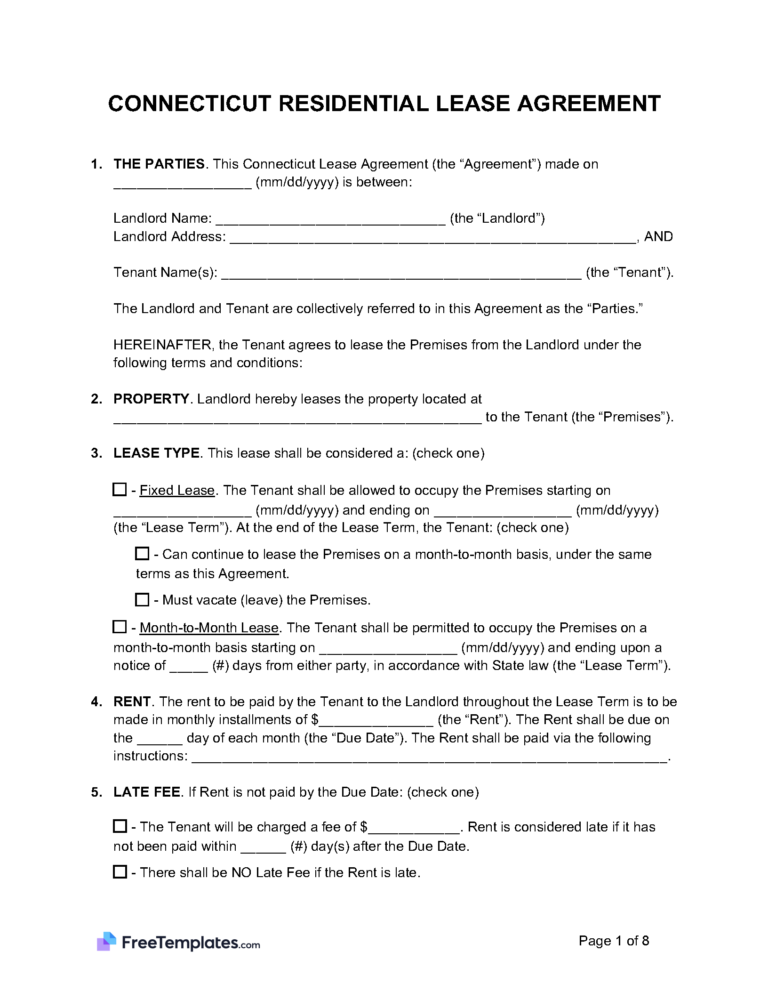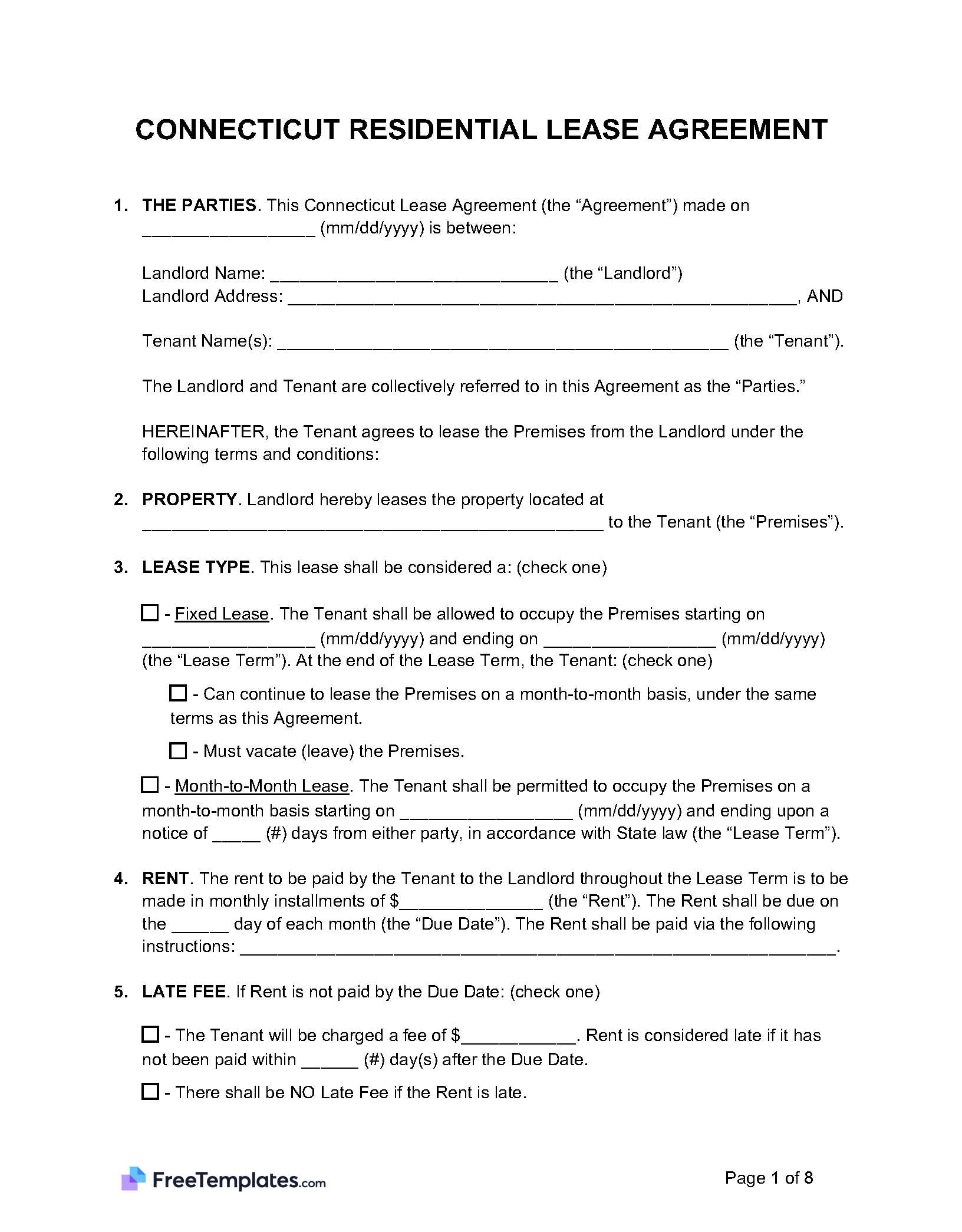By Type (6)
| Standard Lease Agreement – A legal document between a landlord and a tenant for a residential property. The contract can outline terms such as rental payments and lease duration. |
| Commercial Lease Agreement – A contract between a landlord and a business tenant. The formal arrangement can include details such as the business’ intent, the rent amount and duration, as well as the rights and responsibilities of both parties. |
| Month-to-Month Lease Agreement – A more flexible option than standard lease agreements, this is a short-term rental contract between a landlord and a tenant. It typically continues every month until either party decides to end the contractual arrangement. A 30-day notice is standard for termination. |
| Rent-to-Own Agreement – A contractual arrangement between a tenant and a landlord in which a tenant has the option to purchase the property after a specified period. A portion of their rent payments is often applied toward the purchase price, providing a pathway to home ownership. |
| Roommate Agreement – A legal contract between individuals sharing a rental property that outlines each tenant’s responsibilities to ensure a clear understanding of living arrangements. This formal arrangement is in addition to the contract between the landlord and the tenants and can include details such as rent payments, shared utilities, and property maintenance. |
| Sublease Agreement – A legal contract in which a current tenant (sublessor) rents out all or part of a rental property to another individual (sublessee) for a specified period. The sublessee pays rent to the sublessor, who remains responsible to the original landlord. |
Disclosures (3)
Bed Bug Disclosure – Before renting, a landlord must tell a potential tenant if the unit or any nearby units they own, lease, or sublease are infested with bed bugs. If a tenant or potential tenant asks, the landlord must also say when the unit was last inspected and confirmed to be free of bed bugs. (C.G.S. § 47a-7a)
Landlord’s Contact Details – Connecticut law requires landlords to give their tenants the property owner’s or their authorized agent’s name and address. (Conn. Gen. Stat. § 47a-6a)
Lead-Based Paint Disclosure – Landlords must disclose known information about lead-based paint and hazards in rental properties built before 1978, provide a lead hazard information pamphlet, and include specific warning language in the lease.
Security Deposit
Maximum Amount – The security deposit cannot exceed 2 months’ rent for tenants under the age of 62 and 1 month’s rent for tenants who are 62 years of age or older. (Conn. Gen. Stat. § 47a-21)
Handling the Security Deposit – Landlords must place security deposits in an escrow account in a Connecticut bank and notify the tenant of the account details within 30 days. (Conn. Gen. Stat. § 47a-21(C))
- Security Deposit Interest? In Connecticut, the tenant gets interest on their deposit, which cannot be less than the deposit index for that time period. (Conn. Gen. Stat. § 47a-21(C))
Returning Deposit to Tenant – Landlords must return the security deposit with interest, minus any deductions for damages or unpaid rent, within 30 days after the tenant moves out. (Conn. Gen. Stat. § 47a-21(D))
- Itemized Receipt? The landlord must provide an itemized list of the deductions and any remaining deposits. (Conn. Gen. Stat. § 47a-21(D))
Landlord Access
General Access – Landlords must provide reasonable notice (usually 24 hours) before entering a rental unit. (Conn. Gen. Stat. § 47a-16)
- Reasons for Entering the Property? Landlords can only enter at reasonable times and for specific reasons, such as making repairs or showing the property to potential buyers or renters. (Conn. Gen. Stat. § 47a-16)
Emergency Access – In case of an emergency, such as a fire or a burst pipe, landlords can enter the rental unit without notice to address the situation. (Conn. Gen. Stat. § 47a-16)
Paying Rent
Grace Period – Connecticut law does not require landlords to provide a forgiveness period for late rent payments. Rent is due on the date specified in the lease agreement or at the beginning of the lease term.
Maximum Late Fee – The landlord can charge a late fee if rent is not paid on time. However, the fee must be disclosed in the lease agreement. Connecticut law does not specify a maximum late fee amount.
Returned Checks (NSF) – If a tenant has insufficient funds and their check is returned, the landlord can charge a returned check fee. However, the fee cannot exceed $20. (Conn. Gen. Stat. § 52-565a)
Reasons for Eviction (4)
Non-Payment of Rent – The landlord can start eviction if a tenant fails to pay rent. The landlord must provide written notice giving the tenant a least 3 days to pay the rent or leave the property. (Conn. Gen. Stat. § 47a-23(D))
Non-Compliance – If a tenant violates a term of the lease agreement in Connecticut, such as causing damage or engaging in illegal activities, the landlord can start the eviction proceedings. The landlord must give the tenant written notice outlining the lease violation and give the tenant a set period of time to correct the violations or vacate the property. (Conn. Gen. Stat. § 47a-23(C))
Holdover Tenancy – If the tenant remains in the rental unit after the lease term ends without the landlord’s permission, the landlord can start the eviction. The tenant must provide a written notice, giving the tenant a set time to vacate the property. (Conn. Gen. Stat. § 47a-23(A))
Health or Safety Violation – The landlord can begin the eviction if a tenant creates a health or safety danger on the property, such as inflicting or threatening bodily harm to another tenant or the landlord. The landlord must give notice in writing and a set period to correct the violation or leave the rental property. (Conn. Gen. Stat. § 47a-15)

